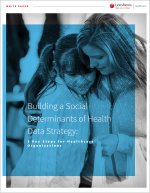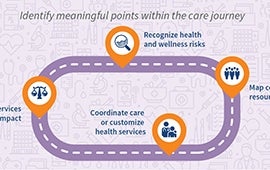Building an SDOH Data Strategy
3 Key Steps to Guide Your Healthcare SDOH Initiative
Your SDOH Initiative Can Help Improve Outcomes and Reduce Costs –But Where to Start?
Across the healthcare ecosystem, organizations are focused on looking beyond clinical needs and addressing the whole needs of the individuals they serve. Strategic focuses on health equity, increased attention to broader community health needs, and investments in addressing social drivers of health are rapidly expanding.
Healthcare organizations understand that social determinants of health (SDOH) can improve health outcomes and minimize medical costs. However, many still miss the opportunity to maximize the use of SDOH data to improve patient outcomes.
Given that SDOH data can come from a variety of sources, healthcare organizations may not fully understand what SDOH data to use, how to integrate the data into their current workflows, nor how to effectively use the insights derived from SDOH data. Finally, many healthcare organizations recognize the value of an SDOH initiative but simply have no idea where to start.
Filling the Data Gaps
Many healthcare organizations attempt to gain insights on SDOH factors by analyzing publicly available datasets and by investing in tools and solutions to collect data directly from patients and healthcare consumers. While these can be important first steps to understanding SDOH, these sources often provide a limited benefit. There are gaps in publicly available data sets, many of which vary in their precision and haven’t been created to be used in healthcare settings.
As healthcare organizations develop SDOH data strategies, the limitations of commonly used data sources illuminate the need for reliable, timely SDOH insights and intelligence. Without comprehensive and accurate SDOH data, healthcare organizations are unable to make meaningful improvements in addressing the social needs of their patients and the communities they serve.
3 Steps to Building a Data Strategy for Your SDOH Initiative

This white paper outlines a three-step process that we believe will help your organization build a strong data strategy for your SDOH initiative. We start with a well-defined focus, followed by an assessment of data sources and gaps. However, for data to be meaningful, you’ll need a strategy to measure impact. We explore various methods for measuring the success of your SDOH initiative. We also use real-world scenarios throughout that illustrate how SDOH data can inform your SDOH program strategy.
Leveraging opportunities to integrate high-quality data intelligence and insights can give a clearer picture of a patient’s health and social needs. It allows healthcare organizations to define customized and effective strategies and accelerates the impact of SDOH initiatives.
A comprehensive strategy to assess, curate and bring together your strongest data sources with intelligence and insights brings a bigger picture into focus, and allows for population-specific initiatives that result in long-lasting improvement.
To start, download the white paper for step-by-step guidance in designing your SDOH initiative.
Access the eBook Here




